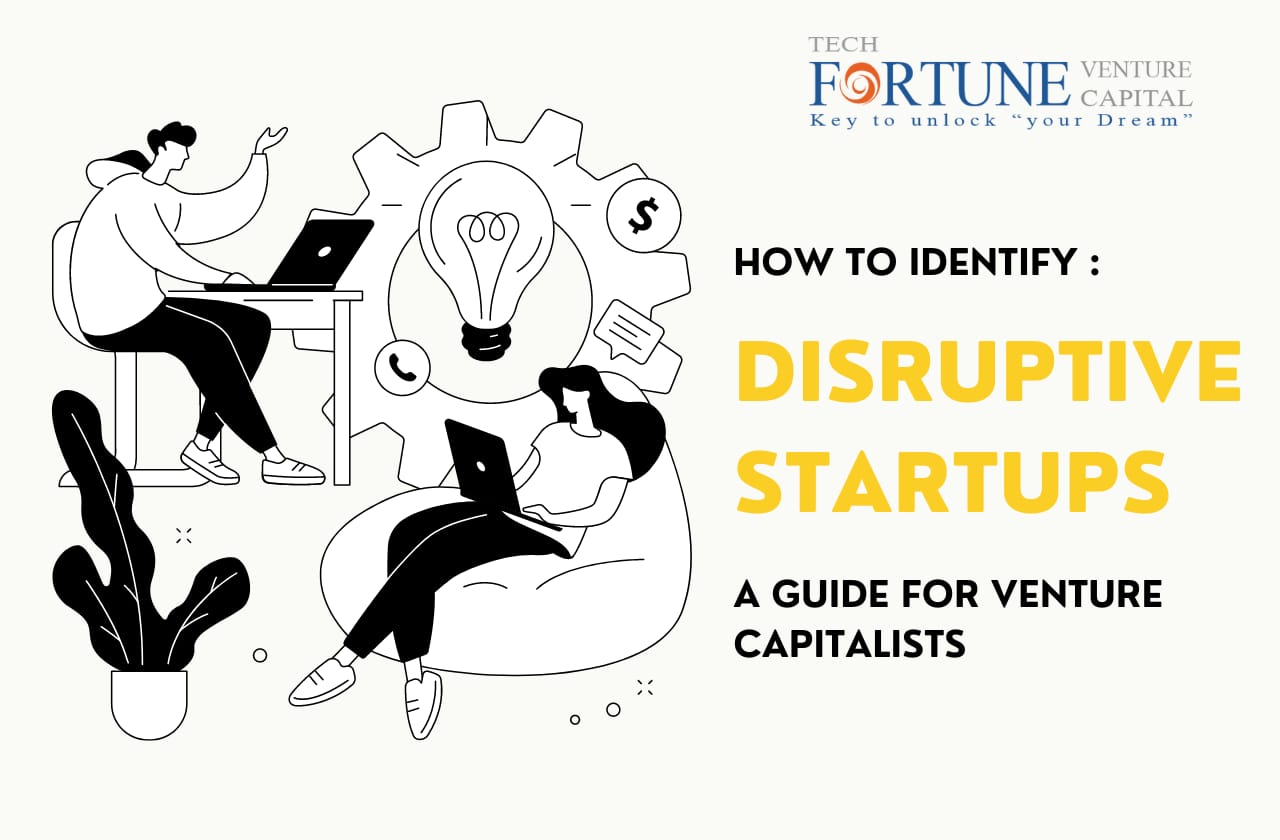“How to Identify Disruptive Startups: A Guide for Venture Capitalists”
“Discovering game-changers with data, vision, and strategic investing in disruptive startups“
In the fast-paced world of venture capital, identifying disruptive startups can be the key to unlocking substantial returns on investment. Disruptive startups are those that redefine industries, introduce groundbreaking innovations, and capture significant market share. For venture capitalists (VCs), recognizing these game-changers early can make all the difference. This guide explores the essential criteria and latest initiatives VCs should consider when identifying disruptive startups.
#1. Innovative Technology and Unique Value Proposition
The cornerstone of any disruptive startup is its technology and unique value proposition. Startups that leverage cutting-edge technologies such as artificial intelligence, blockchain, quantum computing, or biotechnology often stand out. These technologies can create new markets or transform existing ones by offering unprecedented solutions.
Example: OpenAI, with its advancements in artificial intelligence, has disrupted multiple sectors, from customer service to healthcare, by providing AI-driven solutions that were previously unimaginable.
VC Tip: Look for startups with proprietary technology or intellectual property that offers a competitive edge. Assess whether the startup’s value proposition solves a significant problem more efficiently than existing solutions.
#2. Market Potential and Scalability
A disruptive startup targets large, addressable markets with significant growth potential. It’s not just about entering a market but about transforming it. Disruptive startups often begin by addressing niche markets before expanding to mainstream audiences.
Example: Uber started by targeting the black car service industry but quickly scaled to disrupt the entire transportation sector globally.
VC Tip: Evaluate the total addressable market (TAM) and consider the startup’s ability to scale. Look for indications of market readiness and the potential for rapid adoption.
#3. Visionary Leadership and Strong Team
The success of a disruptive startup often hinges on its leadership. Visionary founders who can articulate a clear and compelling vision, adapt to changing market dynamics, and inspire their team are invaluable. A strong, cohesive team with diverse skills complements visionary leadership and drives execution.
Example: Elon Musk’s leadership at Tesla has been pivotal in disrupting the automotive industry with electric vehicles and autonomous driving technology.
VC Tip: Assess the founder’s background, track record, and passion. A strong team with complementary skills and a shared vision is equally important.
#4. Early Traction and Customer Validation
Early traction is a critical indicator of a startup’s potential. Disruptive startups often show signs of product-market fit through initial customer adoption, positive feedback, and growing demand. Customer validation, especially from reputable clients, can signal the startup’s viability.
Example: Slack gained early traction by addressing the communication needs of tech-savvy teams, which led to widespread adoption across various industries.
VC Tip: Look for startups with a growing customer base, positive testimonials, and increasing engagement metrics. Pilot programs and partnerships with established companies can also indicate validation.
#5. Disruptive Business Model
A disruptive startup often employs a business model that challenges traditional industry norms. These models can include subscription services, platform-based ecosystems, freemium offerings, or direct-to-consumer approaches. The goal is to create a new way of delivering value that competitors struggle to replicate.
Example: Netflix revolutionized the entertainment industry with its subscription-based streaming model, moving away from traditional cable and DVD rental services.
VC Tip: Evaluate the sustainability and scalability of the startup’s business model. Consider how it differentiates from incumbents and whether it can generate long-term value.
#6. Alignment with Emerging Trends
Disruptive startups often align with emerging trends and shifts in consumer behavior. These trends can include the rise of remote work, the focus on sustainability, the adoption of digital health solutions, or the growing demand for personalized experiences.
Example: Peloton capitalized on the trend of home fitness and digital connectivity to create a new category of connected fitness equipment.
VC Tip: Stay informed about macro trends and shifts in consumer behavior. Identify startups that are well-positioned to capitalize on these trends with innovative solutions.
Latest Initiatives in Identifying Disruptive Startups
Venture capital firms are continuously evolving their strategies to identify disruptive startups more effectively. Here are some of the latest initiatives:
1. AI and Data Analytics
VCs are increasingly leveraging artificial intelligence and data analytics to identify potential disruptors. By analyzing market trends, consumer behavior, and startup performance metrics, AI can help VCs spot high-potential startups early.
Example: Sequoia Capital uses AI-driven platforms to analyze data from various sources, providing insights into emerging startups and industry trends.
2. Corporate Venture Capital
Many established corporations are setting up venture arms to invest in disruptive startups that align with their strategic goals. This trend allows VCs to co-invest with corporate partners, providing startups with additional resources and market access.
Example: Google Ventures (GV) invests in startups that align with Google’s long-term vision, offering not only capital but also access to Google’s vast resources and expertise.
3. Accelerators and Incubators
VCs are partnering with accelerators and incubators to gain early access to promising startups. These programs provide mentorship, resources, and networking opportunities to startups, increasing their chances of success.
Example: Y Combinator, one of the most renowned accelerators, has produced several disruptive startups, including Airbnb, Dropbox, and Stripe.
4. Crowdsourced Innovation
Some VCs are turning to crowdsourced innovation platforms to discover disruptive startups. These platforms allow innovators from around the world to submit their ideas and startups for consideration.
Example: OurCrowd is a global platform that connects accredited investors with vetted startups, leveraging the collective wisdom of the crowd to identify high-potential investments.
5. Sustainability and Impact Investing
There is a growing focus on sustainability and impact investing. VCs are seeking startups that not only promise high returns but also contribute positively to society and the environment. This approach aligns with the increasing demand for responsible and ethical investing.
Example: Generation Investment Management, co-founded by Al Gore, focuses on sustainable investments, identifying startups that address environmental and social challenges while delivering strong financial returns.
Latest Initiatives in Identifying Disruptive Startups
Venture capital firms are continuously evolving their strategies to identify disruptive startups more effectively. Here are some of the latest initiatives:
1. AI and Data Analytics
VCs are increasingly leveraging artificial intelligence and data analytics to identify potential disruptors. By analyzing market trends, consumer behavior, and startup performance metrics, AI can help VCs spot high-potential startups early.
Example: Sequoia Capital uses AI-driven platforms to analyze data from various sources, providing insights into emerging startups and industry trends.
2. Corporate Venture Capital
Many established corporations are setting up venture arms to invest in disruptive startups that align with their strategic goals. This trend allows VCs to co-invest with corporate partners, providing startups with additional resources and market access.
Example: Google Ventures (GV) invests in startups that align with Google’s long-term vision, offering not only capital but also access to Google’s vast resources and expertise.
3. Accelerators and Incubators
VCs are partnering with accelerators and incubators to gain early access to promising startups. These programs provide mentorship, resources, and networking opportunities to startups, increasing their chances of success.
Example: Y Combinator, one of the most renowned accelerators, has produced several disruptive startups, including Airbnb, Dropbox, and Stripe.
4. Crowdsourced Innovation
Some VCs are turning to crowdsourced innovation platforms to discover disruptive startups. These platforms allow innovators from around the world to submit their ideas and startups for consideration.
Example: OurCrowd is a global platform that connects accredited investors with vetted startups, leveraging the collective wisdom of the crowd to identify high-potential investments.
5. Sustainability and Impact Investing
There is a growing focus on sustainability and impact investing. VCs are seeking startups that not only promise high returns but also contribute positively to society and the environment. This approach aligns with the increasing demand for responsible and ethical investing.
Example: Generation Investment Management, co-founded by Al Gore, focuses on sustainable investments, identifying startups that address environmental and social challenges while delivering strong financial returns.
Latest Initiatives in Identifying Disruptive Startups
Venture capital firms are continuously evolving their strategies to identify disruptive startups more effectively. Here are some of the latest initiatives:
1. AI and Data Analytics
VCs are increasingly leveraging artificial intelligence and data analytics to identify potential disruptors. By analyzing market trends, consumer behavior, and startup performance metrics, AI can help VCs spot high-potential startups early.
Example: Sequoia Capital uses AI-driven platforms to analyze data from various sources, providing insights into emerging startups and industry trends.
2. Corporate Venture Capital
Many established corporations are setting up venture arms to invest in disruptive startups that align with their strategic goals. This trend allows VCs to co-invest with corporate partners, providing startups with additional resources and market access.
Example: Google Ventures (GV) invests in startups that align with Google’s long-term vision, offering not only capital but also access to Google’s vast resources and expertise.
3. Accelerators and Incubators
VCs are partnering with accelerators and incubators to gain early access to promising startups. These programs provide mentorship, resources, and networking opportunities to startups, increasing their chances of success.
Example: Y Combinator, one of the most renowned accelerators, has produced several disruptive startups, including Airbnb, Dropbox, and Stripe.
4. Crowdsourced Innovation
Some VCs are turning to crowdsourced innovation platforms to discover disruptive startups. These platforms allow innovators from around the world to submit their ideas and startups for consideration.
Example: OurCrowd is a global platform that connects accredited investors with vetted startups, leveraging the collective wisdom of the crowd to identify high-potential investments.
5. Sustainability and Impact Investing
There is a growing focus on sustainability and impact investing. VCs are seeking startups that not only promise high returns but also contribute positively to society and the environment. This approach aligns with the increasing demand for responsible and ethical investing.
Example: Generation Investment Management, co-founded by Al Gore, focuses on sustainable investments, identifying startups that address environmental and social challenges while delivering strong financial returns.
Did you know?
According to recent stats, Startups backed by venture capital often grow revenue 3 times faster than those without VC support.
Bottomline:
Discover the future of innovation with Techfortune Venture Capital. Partner with us to unlock disruptive startup opportunities that redefine industries and drive global change. Whether you’re a visionary entrepreneur seeking funding or an investor looking to explore high-potential ventures, Techfortune VC offers strategic insights and robust support.
Join us in navigating the forefront of technological advancement and market disruption. Our commitment to identifying startups with innovative technology, scalable business models, and visionary leadership ensures impactful investments. Together, we can capitalize on emerging trends, from AI-driven solutions to sustainable innovations, shaping the landscape of tomorrow’s industries.
With extensive experience and a network of industry leaders, Techfortune Venture Capital provides more than just capital. We offer mentorship, access to strategic partnerships, and opportunities to scale globally. Embrace the future of venture capital with a partner dedicated to fostering growth and innovation.
Contact Techfortune VC today to explore how we can collaborate to uncover the next generation of game-changing startups. Let’s turn visionary ideas into reality and create lasting value in the evolving world of technology and entrepreneurship. Join us on this journey to redefine possibilities and shape the future together.
Partner with Techfortune VC. Invest in innovation. Transform industries.
FAQ:
Disruptive startups redefine industries with innovative technologies or business models, challenging incumbents. They often solve existing problems in new ways, creating significant market shifts and opportunities.
VCs look for startups with unique value propositions, scalable market potential, visionary leadership, and early signs of market traction. These indicators help identify potential disruptors.
Early traction demonstrates market validation and potential for scalability. It indicates that the startup’s solution resonates with customers, essential for future growth and disruption.
Technology often underpins disruptive innovations. Startups leveraging advanced tech like AI, blockchain, or biotech can transform industries by offering novel solutions and efficiencies.
Startups aligning with emerging trends like sustainability, digital health, or remote work often present disruptive opportunities. VCs track these trends to anticipate future market shifts and investments.

